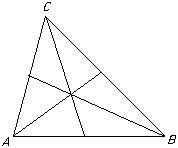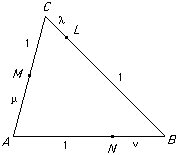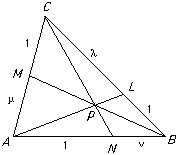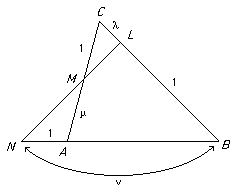 The medians of a triangle are coincident.
The medians of a triangle are coincident.
Proof
If the triangle has vertices a, b and c then it is easy to verify that the medians meet at the point (a + b + c) /3

 Ceva's theorem (due to Giovanni Ceva in about 1678)
Ceva's theorem (due to Giovanni Ceva in about 1678)If the sides BC, CA, AB of a triangle are divided by points L, M, N in the ratios 1 : λ, 1 : μ, 1 : ν then the three lines AL, BM, CN are concurrent if and only if the product λμν = 1.
 Proof
ProofIn fact, we'll prove this using non-affine methods.
λ = CL/LB = Δ CLA/Δ LBA = Δ CLP/Δ LBP = Δ CAP/Δ ABP.
Similarly μ = AM/MC = Δ ABP/Δ BCP and ν = BN/NA = Δ BCP/Δ CAP and the result follows.

 Menelaus's theorem (due to Menelaus in about 100 AD)
Menelaus's theorem (due to Menelaus in about 100 AD)
If the sides of a triangle are divided by points L, M, N in the ratios 1 : λ, 1 : μ, 1 : ν then the three points L, M, N are collinear if and only if the product λμν = -1.
 Proof
Proof
Note that the ratio in which a point L divides an interval AB is negative if L does not lie inside AB.
Draw AP parallel to ML. Then 1/μ = CM/MA = CL/LP and 1/ν = AN/NB = PL/LB.
Then 1/(μν) = CL/LP . PL/LB = -CL/LB = -λ and the result follows.
